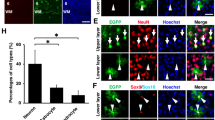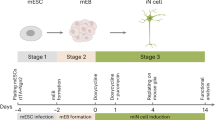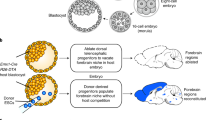Abstract
Targeted ectopic expression of genes in the adult brain is an invaluable approach for studying many biological processes. This can be accomplished by generating transgenic mice or by virally mediated gene transfer, but these methods are costly and labor intensive. We devised a rapid strategy that allows localized in vivo transfection of plasmid DNA within the adult neurogenic niches without detectable brain damage. Injection of plasmid DNA into the ventricular system or directly into the hippocampus of adult mice, followed by application of electrical current via external electrodes, resulted in transfection of neural stem or progenitor cells and mature neurons. We showed that this strategy can be used for both fate mapping and gain- or loss-of-function experiments. Using this approach, we identified an essential role for cadherins in maintaining the integrity of the lateral ventricle wall. Thus, in vivo electroporation provides a new approach to study the adult brain.
This is a preview of subscription content, access via your institution
Access options
Subscribe to this journal
Receive 12 print issues and online access
$259.00 per year
only $21.58 per issue
Buy this article
- Purchase on Springer Link
- Instant access to full article PDF
Prices may be subject to local taxes which are calculated during checkout






Similar content being viewed by others
References
Carlen, M., Meletis, K., Barnabe-Heider, F. & Frisen, J. Genetic visualization of neurogenesis. Exp. Cell Res. 312, 2851–2859 (2006).
Consiglio, A. et al. Robust in vivo gene transfer into adult mammalian neural stem cells by lentiviral vectors. Proc. Natl. Acad. Sci. USA 101, 14835–14840 (2004).
Tashiro, A., Zhao, C. & Gage, F.H. Retrovirus-mediated single-cell gene knockout technique in adult newborn neurons in vivo. Nat. Protoc. 1, 3049–3055 (2006).
Glover, D.J., Lipps, H.J. & Jans, D.A. Towards safe, non-viral therapeutic gene expression in humans. Nat. Rev. Genet. 6, 299–310 (2005).
Lu, P.Y., Xie, F. & Woodle, M.C. In vivo application of RNA interference: from functional genomics to therapeutics. Adv. Genet. 54, 117–142 (2005).
Falk, A. et al. Gene delivery to adult neural stem cells. Exp. Cell Res. 279, 34–39 (2002).
Mir, L.M., Moller, P.H., Andre, F. & Gehl, J. Electric pulse-mediated gene delivery to various animal tissues. Adv. Genet. 54, 83–114 (2005).
Calegari, F., Haubensak, W., Yang, D., Huttner, W.B. & Buchholz, F. Tissue-specific RNA interference in postimplantation mouse embryos with endoribonuclease-prepared short interfering RNA. Proc. Natl. Acad. Sci. USA 99, 14236–14240 (2002).
Inoue, T. & Krumlauf, R. An impulse to the brain–using in vivo electroporation. Nat. Neurosci. 4 (Suppl.), 1156–1158 (2001).
Bajocchi, G., Feldman, S.H., Crystal, R.G. & Mastrangeli, A. Direct in vivo gene transfer to ependymal cells in the central nervous system using recombinant adenovirus vectors. Nat. Genet. 3, 229–234 (1993).
Johansson, C.B. et al. Identification of a neural stem cell in the adult mammalian central nervous system. Cell 96, 25–34 (1999).
Falk, A. & Frisen, J. New neurons in old brains. Ann. Med. 37, 480–486 (2005).
Novak, A., Guo, C., Yang, W., Nagy, A. & Lobe, C.G. Z/EG, a double reporter mouse line that expresses enhanced green fluorescent protein upon Cre-mediated excision. Genesis 28, 147–155 (2000).
Soriano, P. Generalized lacZ expression with the ROSA26 Cre reporter strain. Nat. Genet. 21, 70–71 (1999).
Kempermann, G., Jessberger, S., Steiner, B. & Kronenberg, G. Milestones of neuronal development in the adult hippocampus. Trends Neurosci. 27, 447–452 (2004).
Benraiss, A., Chmielnicki, E., Lerner, K., Roh, D. & Goldman, S.A. Adenoviral brain-derived neurotrophic factor induces both neostriatal and olfactory neuronal recruitment from endogenous progenitor cells in the adult forebrain. J. Neurosci. 21, 6718–6731 (2001).
Pencea, V., Bingaman, K.D., Wiegand, S.J. & Luskin, M.B. Infusion of brain-derived neurotrophic factor into the lateral ventricle of the adult rat leads to new neurons in the parenchyma of the striatum, septum, thalamus, and hypothalamus. J. Neurosci. 21, 6706–6717 (2001).
Gonzalez-Reyes, A. Stem cells, niches and cadherins: a view from Drosophila. J. Cell Sci. 116, 949–954 (2003).
Zhang, J. et al. Identification of the haematopoietic stem cell niche and control of the niche size. Nature 425, 836–841 (2003).
Lechler, T. & Fuchs, E. Asymmetric cell divisions promote stratification and differentiation of mammalian skin. Nature 437, 275–280 (2005).
Nieman, M.T., Kim, J.B., Johnson, K.R. & Wheelock, M.J. Mechanism of extracellular domain-deleted dominant negative cadherins. J. Cell Sci. 112, 1621–1632 (1999).
Matsuda, T. & Cepko, C.L. Controlled expression of transgenes introduced by in vivo electroporation. Proc. Natl. Acad. Sci. USA 104, 1027–1032 (2007).
Lindvall, O. & Kokaia, Z. Stem cells for the treatment of neurological disorders. Nature 441, 1094–1096 (2006).
Kondoh, T. et al. In vivo gene transfer into the periventricular region by electroporation. Neurol. Med. Chir. (Tokyo) 40, 618–623 (2000).
Wei, F. et al. Calmodulin regulates synaptic plasticity in the anterior cingulate cortex and behavioral responses: a microelectroporation study in adult rodents. J. Neurosci. 23, 8402–8409 (2003).
Kuo, C.T. et al. Postnatal deletion of Numb/Numblike reveals repair and remodeling capacity in the subventricular neurogenic niche. Cell 127, 1253–1264 (2006).
Rasin, M.R. et al. Numb and Numbl are required for maintenance of cadherin-based adhesion and polarity of neural progenitors. Nat. Neurosci. 10, 819–827 (2007).
Wong, L.F. et al. Lentivirus-mediated gene transfer to the central nervous system: therapeutic and research applications. Hum. Gene Ther. 17, 1–9 (2006).
Bengzon, J., Mohapel, P., Ekdahl, C.T. & Lindvall, O. Neuronal apoptosis after brief and prolonged seizures. Prog. Brain Res. 135, 111–119 (2002).
Hatakeyama, J. et al. Hes genes regulate size, shape and histogenesis of the nervous system by control of the timing of neural stem cell differentiation. Development 131, 5539–5550 (2004).
Acknowledgements
We thank R. Kageyama (Kyoto University) for the gift of the nestin promoter vector30, C. Ibáñez (Karolinska Institutet) for the gift of a BDNF expression plasmid, M. Wheelock (University of Nebraska Medical Center) for providing the dominant-negative N-cadherin cDNA and K. Fernandes (University of Montreal) for critically reading the manuscript. This study was supported by grants from the Swedish Research Council, the Swedish Cancer Society, the Foundation for Strategic Research, the Karolinska Institutet, Tobias Stiftelsen and the European Commission Framework VI Programme, EuroStemCell. F.B.-H. is supported by a postdoctoral fellowship from Canadian Institutes of Health Research.
Author information
Authors and Affiliations
Contributions
F.B.-H. designed, performed and analyzed the study and wrote the manuscript; K.M. designed and performed most parts of the study; M.E. performed and analyzed part of the study (including BAC analysis); O.B. performed part of the study; H.S. performed and analyzed part of the study; M.A.H. performed EEG analysis; H.M. designed and performed part of the adenoviral study; and J.F. designed the study and wrote the manuscript.
Corresponding author
Supplementary information
Supplementary Text and Figures
Supplementary Figures 1–3, Supplementary Methods (PDF 435 kb)
Rights and permissions
About this article
Cite this article
Barnabé-Heider, F., Meletis, K., Eriksson, M. et al. Genetic manipulation of adult mouse neurogenic niches by in vivo electroporation. Nat Methods 5, 189–196 (2008). https://doi.org/10.1038/nmeth.1174
Received:
Accepted:
Published:
Issue Date:
DOI: https://doi.org/10.1038/nmeth.1174
This article is cited by
-
Multiphoton intravital microscopy of rodents
Nature Reviews Methods Primers (2022)
-
Satb2 is required for the regionalization of retrosplenial cortex
Cell Death & Differentiation (2020)
-
Rapid and efficient gene delivery into the adult mouse brain via focal electroporation
Scientific Reports (2016)
-
In vivo rapid gene delivery into postmitotic neocortical neurons using iontoporation
Nature Protocols (2015)
-
In vivo electroporation to physiologically identified deep brain regions in postnatal mammals
Brain Structure and Function (2015)



